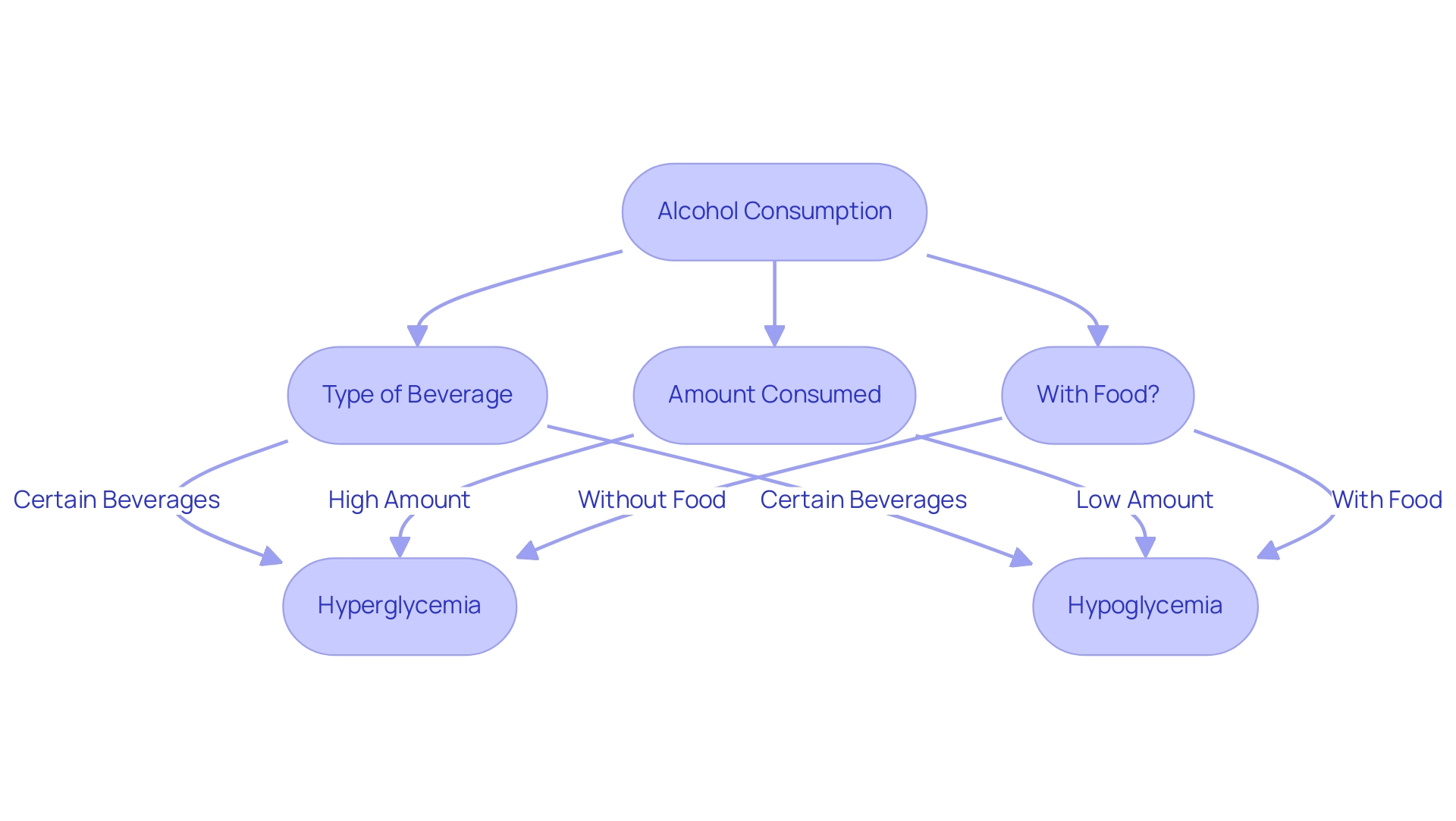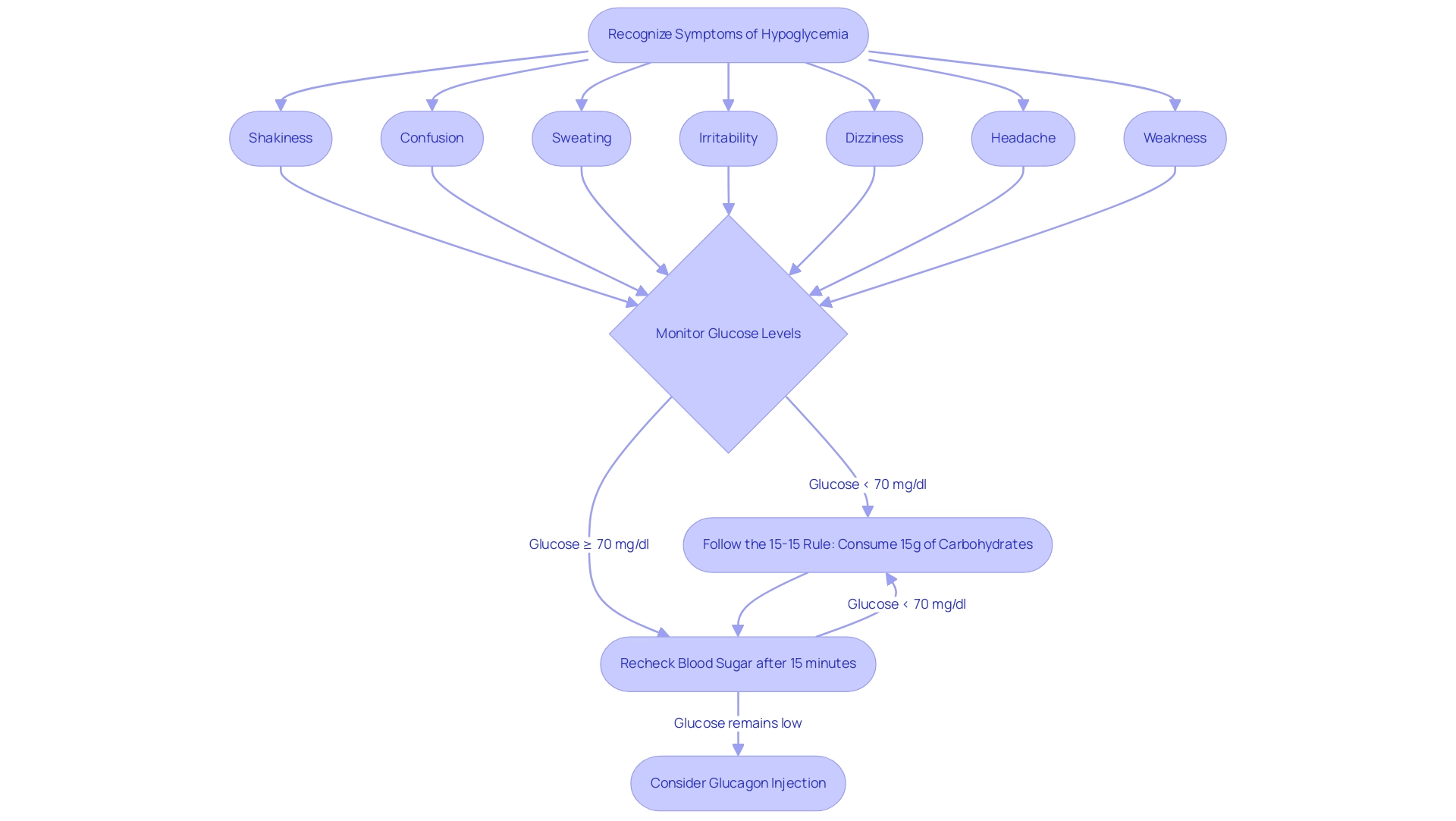Overview:
The article focuses on the safe consumption of alcohol for individuals with type 1 diabetes, emphasizing the potential effects of alcohol on blood sugar levels and providing guidelines for responsible drinking. It highlights that alcohol can lead to both hyperglycemia and hypoglycemia due to its impact on glucose production in the liver, and it offers practical advice, such as monitoring blood sugar levels, choosing low-sugar beverages, and staying hydrated to mitigate these risks.
Introduction
Alcohol consumption presents unique challenges for individuals with type 1 diabetes, significantly influencing blood sugar levels and overall health management. The interplay between different types of alcoholic beverages and their effects on glucose control can lead to both hyperglycemia and hypoglycemia, necessitating a nuanced understanding of safe drinking practices.
This article delves into the critical aspects of alcohol's impact on blood sugar, offering guidelines for safe consumption, recognizing symptoms of alcohol-induced hypoglycemia, and selecting appropriate beverages. By equipping individuals with the knowledge needed to navigate these complexities, effective diabetes management can be achieved, ultimately promoting a healthier lifestyle while enjoying social interactions.
Understanding Alcohol's Impact on Blood Sugar Levels in Type 1 Diabetes
The relationship between alcohol and type 1 diabetes can significantly impact glucose concentrations in individuals. Depending on various factors—including the type of alcoholic beverage, amount consumed, and whether it is ingested with food—alcohol and type 1 diabetes can lead to both hyperglycemia (high glucose levels) and hypoglycemia (low glucose levels). Specifically, alcohol inhibits gluconeogenesis, the liver's process of glucose production, which can result in dangerously low blood sugar amounts, particularly when food intake is insufficient.
In the HPHF-A study, it was found that glycemic control was significantly lower, with GH levels being 39% lower than HPHF-W and 45% lower than LPLF (p=0.000621). This statistic highlights the risks linked to alcohol and type 1 diabetes for individuals managing blood sugar levels. Understanding the distinct impacts of different alcoholic beverages—such as beer, wine, and spirits—is essential for safe consumption practices.
As Dr. Craig E Taplin from the University of Washington observes, 'The connection between alcohol and type 1 diabetes, particularly regarding blood sugar management, is complex and requires careful consideration.' For individuals with type 1 diabetes, it is critical to closely monitor blood glucose levels in relation to alcohol and type 1 diabetes before, during, and after drinking. Additionally, referencing the SEARCH Cohort Visit results, which indicated suboptimal glycemic control among participants with a mean HbA1c of 9.1%, highlights the need for improved management strategies for the condition.
Learning to identify the signs of alcohol-induced hypoglycemia can be a crucial aspect of effective management for those dealing with alcohol and type 1 diabetes, ultimately assisting in reducing the risks linked to alcohol consumption.

Safe Drinking Guidelines for Individuals with Type 1 Diabetes
To ensure safe drinking practices with type 1 condition, adhere to the following guidelines:
- Consult with Your Healthcare Provider: Prior to consuming alcohol and type 1 diabetes, engage in a discussion with your healthcare team to understand the potential impact of alcohol on your diabetes management. This step is crucial for personalized advice that aligns with your specific health needs.
- Know Your Limits: Get to know the quantity of alcohol you can safely take without negatively impacting your glucose measurements. It is advisable to adhere to established guidelines for moderate drinking, which typically recommend no more than four standard drinks on a single occasion. Heavy drinking (i.e., more than 140 grams of pure alcohol, or approximately 12 standard drinks, per day) can cause alcohol-induced hypertriglyceridemia in both diabetics, particularly those with alcohol and type 1 diabetes, and nondiabetics, as noted by Chait et al.
- Choose Wisely: Select beverages with reduced sweetness, such as dry wines or spirits mixed with calorie-free mixers. It is advisable to steer clear of sweet cocktails and sugary beverages, as these can greatly affect glucose concentrations.
- Eat Before and While Drinking: Always consume a meal or snack before drinking and consider continuing to eat while you drink. This practice can aid in stabilizing glucose concentrations throughout the evening for individuals managing alcohol and type 1 diabetes.
- Monitor Your Sugar Levels: Regularly check your glucose levels before, during, and after alcohol consumption to promptly identify any fluctuations that may arise.
-
Have a Plan: Carry a source of fast-acting glucose, such as glucose tablets or juice, to address potential hypoglycemia. Additionally, inform friends or companions about your condition, so they can assist you if necessary.
-
Alcohol-Free Days: It is recommended that adults have at least 2-3 alcohol-free days each week to promote better overall health and sugar control. A notable case study illustrates the potential dangers of alcohol and type 1 diabetes: a 23-year-old woman with type 1 diabetes experienced severe hypoglycemia after drinking at a social event, despite using an advanced hybrid closed-loop insulin delivery system. This incident highlights the significance of careful management and awareness of glucose levels when consuming alcohol. Furthermore, the consumption of alcohol and type 1 diabetes is a recognized risk factor for diabetic retinopathy, highlighting the need for caution. Following the recommended guidelines can help mitigate risks and ensure a safer drinking experience.

Recognizing the Signs of Alcohol-Induced Hypoglycemia
The consumption of alcohol and type 1 diabetes poses significant risks for individuals with blood sugar issues, particularly concerning hypoglycemia. It can hide the usual indications of low glucose levels, which include:
- Shakiness
- Confusion
- Sweating
- Irritability
- Dizziness
Recognizing these symptoms is crucial, especially for those with alcohol and type 1 diabetes.
If you observe any of these indications while consuming beverages, it is crucial to monitor your glucose status promptly. Additional symptoms such as headache, weakness, or fatigue may also arise. Recent studies suggest that ethanol concentrations can influence glucose control, with ΔEthanol at 180 min for OATT measured at 0.11 ± 0.13 mg/mL.
In the event that hypoglycemia is confirmed, it is recommended to follow the '15–15 rule': consume 15 grams of fast-acting carbohydrates, such as glucose tablets or juice, and recheck blood sugar amounts after 15 minutes. If values stay beneath 70 mg/dl, repeat the process. If treatment is not safe or effective, glucagon injections may be required.
As noted by Thornton PS, recognizing hypoglycemia symptoms is essential for effective management. Awareness of how alcohol and type 1 diabetes affect your body, especially regarding the potential to mask hypoglycemia symptoms, can enhance your ability to manage your diabetes effectively. A case study titled 'Management of Hypoglycemia in Diabetics' emphasizes the importance of prompt treatment for low glucose levels, illustrating the '15–15 rule' in action.

Choosing the Right Alcoholic Beverages
Choosing suitable alcoholic drinks is essential for effective blood glucose management, especially for newly diagnosed patients dealing with alcohol and type 1 diabetes. According to a 2021 Drizly.com survey, consumers prioritize factors such as calorie count (20%), content (17%), and added health benefits (12%) when choosing alcohol. As we launch T2DSolutions, your comprehensive resource for Type 2 and Type 3 conditions management, we will provide educational articles, community support, and expert guidance on making informed choices.
Here are some optimal choices to consider:
- Dry Wines: Both red and white dry wines generally contain lower levels of sweetness compared to their sweet counterparts, making them a favorable option for individuals managing diabetes.
- Light Beers: These beers generally contain fewer carbohydrates than regular types, making them a safer option for individuals worried about glucose fluctuations.
- Spirits: Clear spirits such as vodka, gin, and tequila are inherently low in carbohydrates.
To maintain a low sweetener intake, mix these spirits with calorie-free mixers, like soda water or diet tonic water.
- Avoid Sweet Cocktails: It is essential to avoid cocktails that incorporate sweet mixers or syrups, as these can cause rapid increases in blood glucose levels. Notably, liqueurs like Kahlua can contain as much as 33 grams of sugar per serving, highlighting the importance of checking labels for hidden sugars, particularly in flavored alcoholic beverages.
By being mindful of these selections and ingredient lists, individuals can enjoy their drinks while better managing their health, especially regarding alcohol and type 1 diabetes. Additionally, beverage trends post-pandemic have shifted towards simple pleasures and low-sugar options, aligning with the need for diabetic-friendly choices. T2DSolutions is here to support you with accurate information and community guidance as you navigate your health management journey.

The Importance of Hydration While Drinking
Maintaining proper hydration is essential for individuals with type 1 diabetes, particularly when considering the effects of alcohol and type 1 diabetes. The consumption of alcohol can lead to dehydration, which may worsen the effects of both hypoglycemia and hyperglycemia in individuals with alcohol and type 1 diabetes. Research indicates that individuals with daily water intake between 0.5 to 1.0 liters have a significantly lower odds ratio of experiencing new-onset hyperglycemia, standing at 0.64 compared to those with lower intake.
To ensure adequate hydration, it is recommended to drink water before, during, and after consuming alcohol and type 1 diabetes. A practical guideline is to consume one glass of water for each alcoholic beverage. This method not only helps with hydration but also reduces alcohol absorption, thereby lessening its possible effect on glucose concentrations.
Furthermore, it is advisable to avoid caffeinated beverages, as they can contribute to further dehydration. Health experts highlight that hydration techniques are essential in regulating glucose levels efficiently, particularly in the context of alcohol and type 1 diabetes. According to The Diabetes Council, if you find yourself in a situation where you need to reduce your glucose levels quickly, it is advised to:
- Drink water
- Elevate your heart rate
- Eat a high-protein snack
In cases where rapid blood sugar reduction is necessary, utilizing hydration techniques along with other methods—such as those outlined in the case study titled 'Lowering Blood Sugar Quickly'—can be beneficial. These strategies highlight the interconnectedness of hydration and effective diabetes management.

Conclusion
Understanding the complexities of alcohol consumption is essential for individuals with type 1 diabetes. Alcohol can significantly affect blood sugar levels, leading to both hyperglycemia and hypoglycemia. By recognizing the specific impacts of various alcoholic beverages and adhering to safe drinking guidelines, individuals can better manage their condition while still enjoying social interactions. Key recommendations include:
- Consulting healthcare providers
- Knowing personal limits
- Monitoring blood sugar levels closely
Awareness of alcohol-induced hypoglycemia is critical, as it can mask typical symptoms, making it harder to identify when blood sugar levels drop dangerously low. The '15-15 rule' is a practical strategy for addressing hypoglycemia, emphasizing the importance of prompt action to ensure safety. Additionally, choosing the right alcoholic beverages—such as dry wines and light beers—can help mitigate risks associated with drinking.
Hydration also plays a vital role in managing blood sugar levels while consuming alcohol. Adequate water intake can prevent dehydration, which exacerbates blood sugar fluctuations. By implementing these strategies, individuals with type 1 diabetes can navigate the challenges of alcohol consumption more effectively, fostering a healthier approach to social drinking. Ultimately, informed choices and proactive management can lead to a balanced lifestyle that accommodates both diabetes care and social enjoyment.



